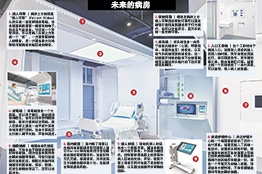
The hospital room may be due for a checkup.
醫(yī)院病房或許該做一次檢查了。
Doctors and nurses, architects and designers all say the room setting has an important but largely neglected role to play in the delivery of quality care and outcomes.
醫(yī)生和護士、建筑師和設(shè)計師都說,病房環(huán)境對于優(yōu)質(zhì)護理與優(yōu)質(zhì)診療結(jié)果的達成發(fā)揮著重要的作用,然而這種作用基本上都是被忽略了的。
Consider infections. One out of every 20 patients admitted to a hospital picks up an infection while there, according the Centers for Disease Control and Prevention. These infections can be serious and deadly, and they cost the U.S. $10 billion a year.
以感染為例。據(jù)美國疾病控制與預(yù)防中心(Centers for Disease Control and Prevention)數(shù)據(jù),在美國,每20個入院病人就有一人在住院期間感染某種疾病。這些疾病有可能是嚴重而致命的,每年為此付出的代價高達100億美元。
But recent studies indicate that at least half can be avoided. And the design of patient rooms is one of the best places to start.
但近期研究表明,至少一半的感染是可以避免的。病房的設(shè)計是最佳切入點之一。
The hospital room has changed little since the post-World War II years, when there was a shift to semiprivate rooms from wards. But even then, the patient wasn't central to the plan. Now, the patient room of the future is being designed as a safe, private, comfortable place conducive to healing.
二戰(zhàn)之后的那些年里,多人共用的大病房被陸續(xù)改為二到四人共用的半私密病房,之后基本上就沒有變化。然而即便在當(dāng)時,病房的改造也不是圍繞病人而展開的。如今,未來的病房正在被設(shè)計成一個安全、私密、舒適、有利于康復(fù)的地方。
'With all the knowledge we've gained,' says Douglas Wood, director of the Mayo Clinic Center for Innovation, 'we can increasingly create an environment in the hospital to minimize the transmission of bacteria, increase the circulation of air, and reduce pain, discomfort and poor clinical outcomes.'
梅奧診所(Mayo Clinic)創(chuàng)新研究中心主任道格拉斯・伍德(Douglas Wood)說:“利用我們已經(jīng)獲知的各種知識,我們越來越有能力在醫(yī)院里面打造一種最大化降低細菌傳播,增加空氣循環(huán),減少疼痛、不適和劣質(zhì)診療結(jié)果的環(huán)境。”
Hospital officials from across the U.S. and abroad have traveled to New York to see the prototype patient room shown here. Designed by NXT Health, a nonprofit in New York, and funded by the Department of Defense, the room is designed to reduce infections, falls, errors -- and ultimately costs. Here's a look at how it would do so.
全美各地以及美國國外都有醫(yī)院管理人員前往紐約參觀本文所示的這間樣板病房。這間病房由紐約非營利組織NXT Health設(shè)計、美國國防部資助,其出發(fā)點是減少感染、摔倒和差錯――最終就是減少要付出的代價。讓我們大概了解一下它是怎樣實現(xiàn)這些目標(biāo)的。
1. Patient Ribbon
1•“病人環(huán)帶”
The canopy above the bed, the patient ribbon, extends from the head wall to the footwall. It contains electrical, technological and gas components normally found in any hospital room. It also includes a sound system that can create a cocoon above the patient's head to block out unwanted noise and minimize the transmission of noise to other areas of the room.
病床上方的頂蓋“病人環(huán)帶”(Patient Ribbon)從床頭墻一直延伸到床尾墻,包含普通病房里面一般都有的電子、技術(shù)及氣體設(shè)備。它還有一個聲音系統(tǒng),可以在病人頭部上方形成一個“繭”,一方面屏蔽掉惱人的噪音,另一方面也最大化地降低傳到病房其他區(qū)域的噪音。
2. Halo Lightbox
2. 暈輪燈箱
The halo lightbox in the patient ribbon above the bed can be programmed for mood or light therapy, and can simulate cloud movements, blue skies and other lighting conditions.
鑲嵌在病床上方病人環(huán)帶里的暈輪燈箱可以通過編程打造特定氛圍或用于燈光理療,也可以模擬浮云、藍天和其他一些光線環(huán)境。
3. Head Wall
3. 床頭墻
The head wall contains the equipment needed to check vital signs (heartbeat, breathing rate, temperature and blood pressure), as well as oxygen and other supplies, all stowed neatly out of sight but easily accessible through pull-down panels in the wall.
床頭墻包含一臺用于檢查關(guān)鍵指標(biāo)(心跳、呼吸頻率、體溫和血壓)的設(shè)備,以及氧氣和其他物資供給設(shè)備。這一切都整齊地收納起來不會被看到,但可以通過床頭墻內(nèi)的下拉式面板輕松調(diào)用。
4. Footwall
4. 床尾墻
The footwall contains a large screen that can be used for entertainment, video consultations with doctors, and access to hospital information, educational content and social-media sites. It's controlled from the bed by a tablet computer that allows the patient to adjust lighting, sound, and temperature.
床尾墻包含一個大屏幕,可以用于娛樂、通過視頻咨詢醫(yī)生,也可以用來訪問醫(yī)院信息、教育內(nèi)容和社交網(wǎng)站。病人在病床上通過一臺平板電腦來對其進行控制。這臺電腦還允許病人調(diào)節(jié)光線、聲音和溫度。
5. Rubber Floors
5. 橡膠地板
The floors are made of low-porosity rubber, which doesn't contain or need chemical sealers or waxes that often trap bacteria and other substances that can cause infections and allergic reaction. Rubber is quieter, softer and less slippery than other traditional floor materials. In case of a fall, it reduces impact.
地面由細孔橡膠鋪成,不包含也不需要化學(xué)密封材料或蠟油,因為這些東西常常會藏納細菌等物質(zhì),可能引起感染和過敏反應(yīng)。橡膠比其他傳統(tǒng)地面材料要安靜、柔軟、防滑。在發(fā)生摔倒的情況下,還可以減輕沖擊。
6. Room Surfaces
6. 室內(nèi)表面
All surfaces in the room other than the floor are made of Corian or similar solid-surface materials commonly found in homes as kitchen countertops. The material is nonporous and seamless, making it easy to clean and minimizing the chances for mold, mildew or bacteria to grow. That all reduces the risk of infection.
室內(nèi)除了地面以外的其他表面都采用可麗耐人造石(Corian)和其他常用作住宅廚房臺面的硬表面材料。這些材料無孔無縫,容易清潔,并將發(fā)霉、生長細菌的概率最小化。這些都會降低感染風(fēng)險。
7. Entry Workstation
7. 入口工作站
The workstation is located at the entrance to the patient room. As a staff member or other person enters, the sink lights up in red to indicate that hands should be washed. When hands are disinfected, a green light blinks. A dashboard in the wall stores a computer, where information on the patient can be found and entered.
這個工作站位于病房入口。當(dāng)醫(yī)院人員或其他人員進入的時候,洗手臺就會亮起紅燈,表示需要洗手。雙手消完毒之后,就會有綠燈閃爍。墻面上的一個儀表板放了一臺電腦,可以查閱、錄入病人的資料。
8. Bedside Caregiver Hub
8. 床邊護理中心
At the bedside caregiver hub, a wall panel holds another computer. Other technology is embedded in the wall, and when the panel is closed, ultraviolet light kills bacteria that might have formed on surfaces. The computer keyboard, like all others in the room, is a flat, nonporous typing surface that's easy and quick to clean, unlike conventional keyboards, which can harbor bacteria.
床邊護理中心的一個墻面面板容納了另外一臺電腦。墻面還植入了其他一些技術(shù),當(dāng)面板關(guān)閉的時候,就會有紫外線殺滅各處表面上可能已經(jīng)形成的細菌。電腦鍵盤和病房內(nèi)的其他所有鍵盤一樣,都是一個平坦無孔的輸入表面,清潔起來方便快捷,不像常規(guī)鍵盤那樣可能會藏納細菌。
9. Patient Companion
9. 病人伴侶
The mobile patient companion contains both an eating surface and a flat computer when flipped over. Operated by touch, the computer controls the screen on the footwall and the light and sound in the patient area. The surface has colored rings to indicate when power is low and icons to touch to call for help.
移動式病人伴侶包含一個就餐平面,翻過來就是一臺平板電腦。電腦為觸控式,控制著床尾墻面上的屏幕和病人區(qū)域的光線、聲音。就餐平面上有表示何時電量不足的彩色圓圈,以及通過觸摸尋求幫助的圖標(biāo)。












